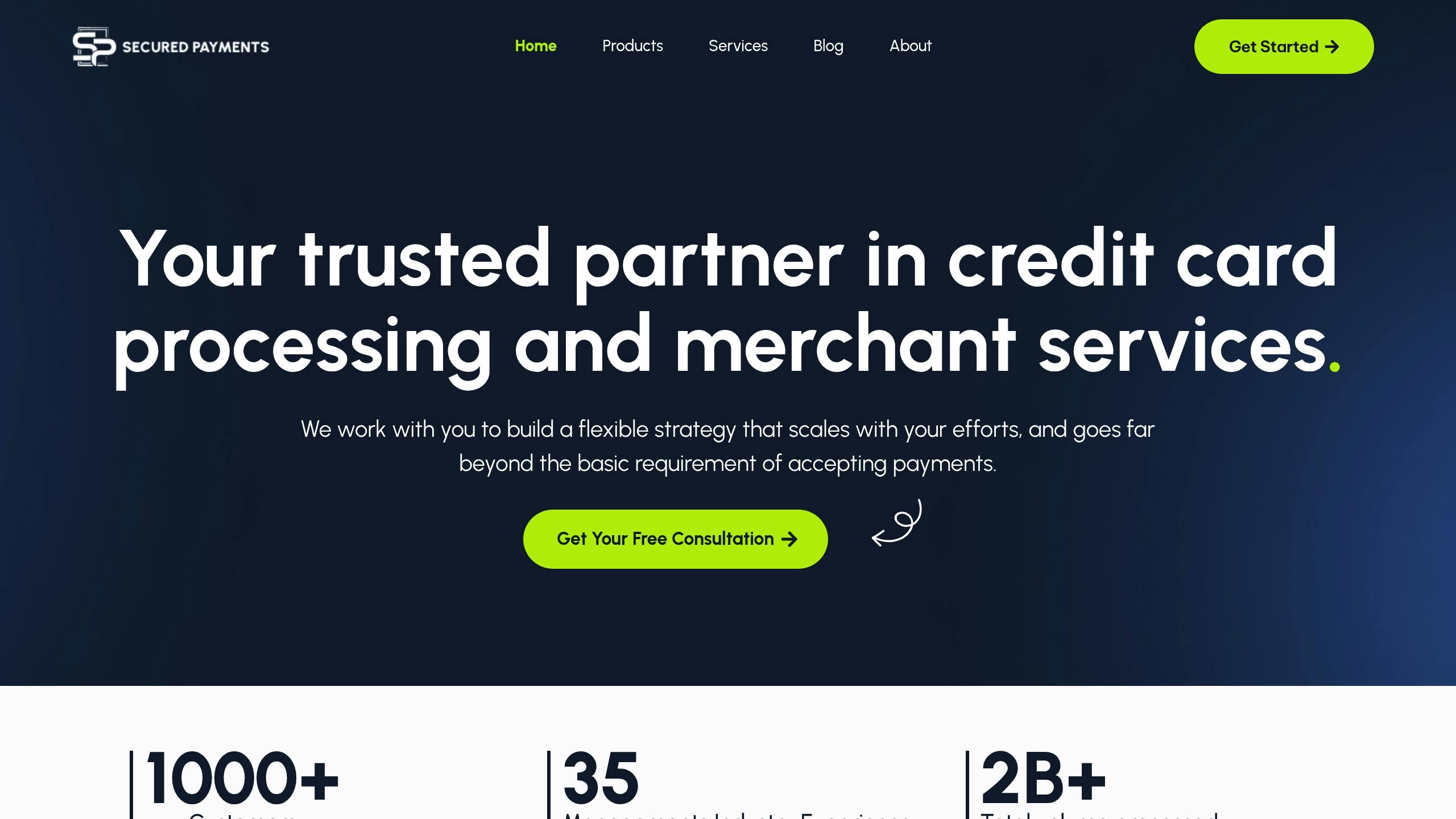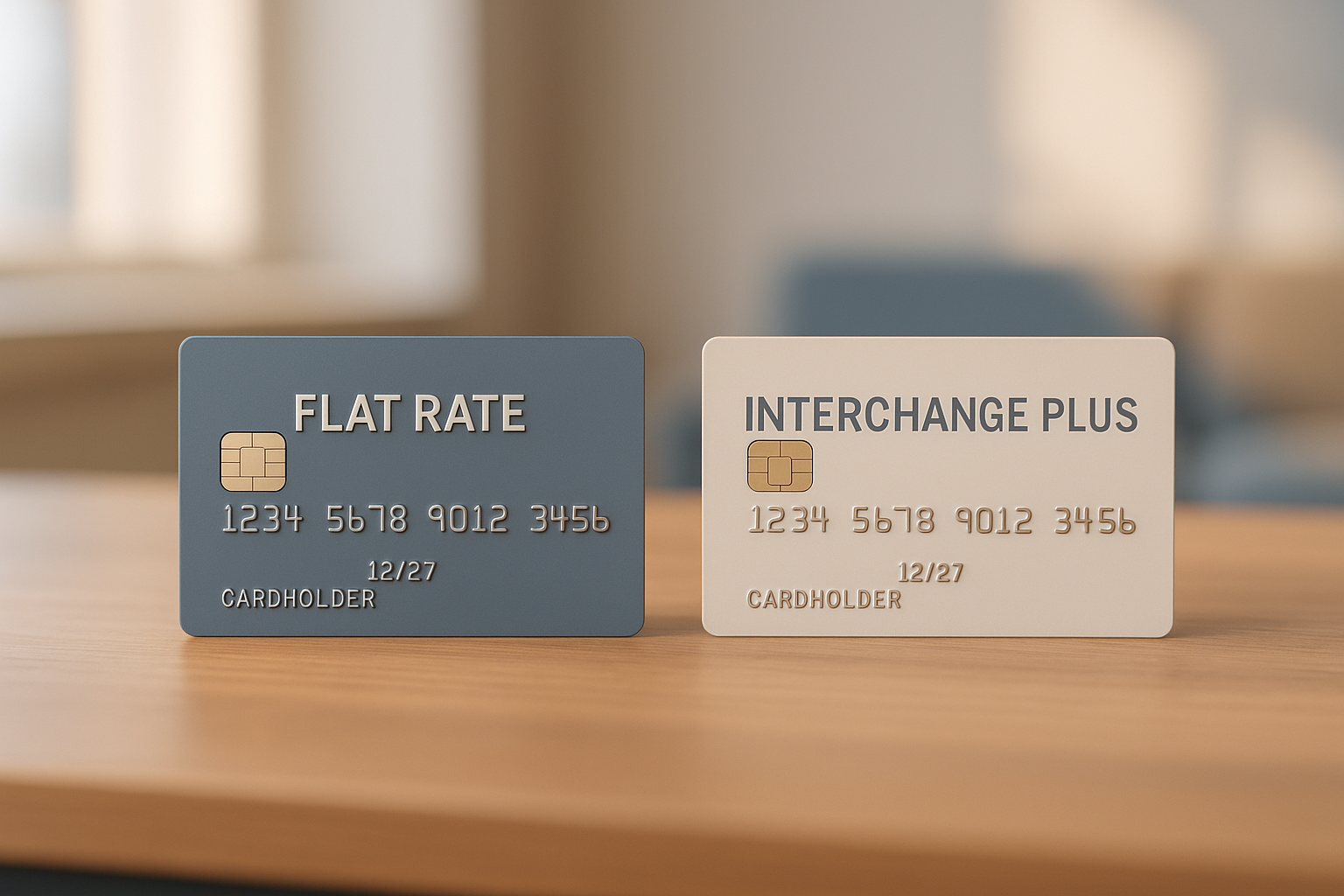Choosing the right payment processing model can save your business thousands of dollars annually. Here’s what you need to know:
- Flat Rate Pricing: Simple and predictable, with a fixed percentage (e.g., 2.9%) plus a small fee per transaction. Best for small businesses earning under $200,000/year.
- Interchange Plus Pricing: Breaks fees into components (interchange, card brand, and processor markup). Offers transparency and lower costs for businesses earning over $200,000/year.
Quick Comparison:
| Aspect | Flat Rate | Interchange Plus |
|---|---|---|
| Cost Structure | Fixed rate (e.g., 2.9% + $0.30) | Interchange + markup (e.g., 2.1%) |
| Best For | Small businesses | High-volume businesses |
| Transparency | Medium | High |
| Monthly Fees | None | $10–$20 |
| Savings Potential | Limited | Up to 48% savings for large volumes |
For businesses processing large volumes (e.g., $10M annually), interchange plus pricing could save up to $80,000/year. Smaller businesses may prefer flat rate pricing for its simplicity.
Keep reading to understand how these models work and which one suits your business.
Flat-Rate vs. Interchange-Plus Pricing 🤓
Flat Rate Pricing Explained
Flat rate pricing is a straightforward way to manage processing costs, offering a fixed rate for every card transaction. This approach simplifies budgeting and ensures predictable expenses.
Flat Rate Pricing Basics
With flat rate pricing, businesses are charged a fixed percentage of the transaction amount plus a per-transaction fee. Here’s what that typically looks like:
- A percentage of the transaction amount
- A flat fee per transaction
Currently, rates usually fall between 2.29% and 3.5%, with an additional $0.09 to $0.30 per transaction [4]. The exact rate depends on how the transaction is processed:
| Transaction Type | Typical Rate Range | Example Fee Breakdown |
|---|---|---|
| In-Person (Card Present) | 2.29% – 2.6% + $0.09–$0.10 | $100 purchase = $2.39–$2.70 total fee |
| Online/Manual Entry | 2.9% – 3.49% + $0.09–$0.30 | $100 purchase = $2.99–$3.79 total fee |
"Flat rate credit card processing is simple, but is it the right fit for your business? Explore the pros and cons to find out." – Danny Randell, Helcim [5]
Now, let’s dive into the advantages and disadvantages of this pricing structure.
Flat Rate Pricing Benefits and Drawbacks
Flat rate pricing offers simplicity, but it’s not always the most cost-effective choice. Here’s a quick breakdown:
| Benefits | Drawbacks |
|---|---|
| Predictable monthly costs | Higher costs for businesses with high transaction volumes |
| Easy-to-understand fee structure | Limited opportunities to lower processing fees |
| Simplifies budgeting and accounting | Rates are non-negotiable |
| Uniform rates for all card types | Markups added to account for interchange rate fluctuations |
| No hidden fees or unexpected charges | Can lead to overpaying for low-risk transactions |
For businesses with lower transaction volumes, this model’s simplicity can be a major advantage. However, if your business processes a large number of transactions, the flat rate markup – added to cover fluctuations in interchange rates – can result in higher overall costs. Interchange rates, which typically range from 1.29% to 2.7% [4], are often much lower than flat rate charges, making the markup particularly noticeable for high-volume businesses.
Interchange Plus Pricing Explained
Interchange plus pricing breaks down costs clearly, offering a detailed view of what businesses are paying for credit card transactions. This pricing model has gained popularity, especially as U.S. businesses paid a staggering $100 billion in credit card processing fees to Visa and Mastercard in 2024 [1].
Interchange Plus Pricing Basics
This pricing structure includes three main components:
| Fee Component | Description | Typical Range |
|---|---|---|
| Interchange Fee | Base fee paid to the card-issuing banks | Varies by card type |
| Card Brand Fee | Fee for using the card network | 0.10% – 0.15% |
| Processor’s Markup | Additional fee charged by the payment processor | 0.20% – 0.50% |
In practice, rates are typically quoted as: interchange + card brand fee + 0.40% + 8¢ [1].
Interchange Plus Pricing Benefits and Drawbacks
This pricing model comes with both perks and challenges:
| Benefits | Drawbacks |
|---|---|
| Clear visibility into cost breakdown | Monthly statements can be complex |
| Lower costs for merchants with high volumes | Requires understanding of fee structures |
| Processor markups are negotiable | Monthly costs can fluctuate |
| Savings on lower-interchange card transactions | Harder to budget consistently |
| Potential for better rates as volume increases | Increased administrative effort |
Studies show that businesses can save anywhere from 20% to 48% using interchange plus pricing [2]. This is particularly impactful since interchange fees often make up 70% to 90% of total processing costs [7].
However, the cost-effectiveness of this model depends on several factors:
- Transaction Volume: Businesses with higher transaction volumes tend to see greater savings.
- Average Transaction Size: Larger transactions can lead to more noticeable cost reductions.
- Card Mix: The types of cards customers use (e.g., rewards cards vs. debit cards) affect interchange rates.
- Processing Methods: The balance between in-person and online transactions can influence overall fees.
To maximize savings, businesses should regularly review their processing statements and stay aware of any changes in interchange fees [7]. This hands-on approach can make a significant difference. Up next, we’ll directly compare pricing models to better understand their unique strengths and practical applications.
sbb-itb-8c45743
Direct Model Comparison
The latest data from 2024 highlights clear differences in cost and management needs between pricing models.
Price Differences
The cost-effectiveness of each pricing model depends heavily on the size of the business and its transaction volume. Here’s a snapshot of typical annual savings across different business types:
| Business Type | Annual Revenue | Flat Rate Cost | Interchange Plus Cost | Annual Savings |
|---|---|---|---|---|
| Small Coffee Shop | $180,000 | $15,600 | $3,600 | $12,000 |
| Consulting Firm | $80,000 | $2,320 | $2,520 | -$200 |
| E-commerce Retailer | $10,000,000 | $290,000 | $210,000 | $80,000 |
For businesses processing more than $200,000 annually, interchange plus pricing often results in significant savings. However, smaller businesses might lean toward flat rate pricing, as it eliminates monthly fees, which typically range between $10 and $20 [3].
Fee Structure Clarity
One of the standout differences between the two models lies in how fees are presented. Here’s a breakdown:
| Aspect | Flat Rate | Interchange Plus |
|---|---|---|
| Fee Breakdown | Single combined rate | Detailed component breakdown |
| Cost Visibility | Limited | Full transparency |
| Statement Complexity | Simple, one-line items | Detailed, itemized statements |
| Price Negotiation | Fixed rates, non-negotiable | Negotiable processor markup |
"Interchange-plus pricing gives you a clear breakdown of all fees on your monthly merchant statement, letting you see exactly what you’re paying for each card and transaction type." – Helcim [2]
The detailed transparency provided by interchange plus pricing not only clarifies costs but also affects the level of administrative effort required.
Management Requirements
Each pricing model comes with different levels of operational oversight. Flat rate pricing is straightforward, requiring little to no monitoring. On the other hand, interchange plus pricing demands more attention. Businesses need to regularly review statements, understand fee components, and allocate administrative resources to manage the process effectively [8][6].
This additional effort can be worth it. Studies show that businesses opting for interchange plus pricing can save between 20.20% and 48.45% compared to flat rate processors [2]. For many, these savings justify the extra time and effort.
Selecting Your Pricing Model
Key Selection Criteria
When choosing a pricing model, it’s all about aligning the structure with your business’s unique profile. Factors like transaction volume, annual revenue, and your overall operating model play a crucial role in determining the best fit.
For instance, businesses processing over $200,000 annually often find interchange plus pricing more cost-effective, with potential savings of 20%–48% compared to flat rate pricing [2]. On the other hand, smaller businesses might lean toward flat rate pricing for its simplicity and predictable costs, which require less administrative effort.
Here’s a quick breakdown to guide your decision:
| Business Characteristic | Recommended Model | Why It Works |
|---|---|---|
| Revenue under $200,000 | Flat Rate | Lower monthly fees and easier accounting |
| Revenue over $200,000 | Interchange Plus | Greater savings despite added complexity |
| High Transaction Volume | Interchange Plus | Better rates for frequent, smaller transactions |
| Low Transaction Volume | Flat Rate | Predictable expenses with minimal management |
| E-commerce Focus | Interchange Plus | Optimized for handling diverse card types and costs |
| Retail/Service Focus | Flat Rate | Straightforward pricing for consistent transaction patterns |
This table underscores how your business’s specific traits can help steer you toward the right pricing model.
Secured Payments Options

Once you’ve settled on the pricing model that fits your business, Secured Payments can help you put it into action. Their tailored solutions are designed to optimize your processing costs while keeping things efficient.
Here’s what they bring to the table:
- Custom Rate Analysis: They analyze your transaction patterns to recommend the best pricing model for your business.
- Clear Fee Breakdown: No hidden costs – every fee is transparently outlined.
- Flexibility: You can easily adjust pricing models as your business evolves.
- 24/7 Support: Around-the-clock assistance for any payment or fee-related concerns.
The Secured Payments team takes the guesswork out of complex pricing decisions by diving into your transaction data, customer preferences, and industry nuances. This ensures you land on a solution that balances cost-effectiveness with operational ease. With their support, transitioning to the pricing model that fuels your business growth becomes a smooth and efficient process.
Summary
Here’s a quick breakdown of the key takeaways:
Choosing between flat rate and interchange plus pricing can have a big impact on your business’s expenses. It’s a decision that directly affects how much you save – or spend – on payment processing.
| Aspect | Flat Rate | Interchange Plus | Best For |
|---|---|---|---|
| Cost Structure | Fixed rate (e.g., 2.6% + 10¢) | Variable (interchange + markup) | Small businesses / High-volume merchants |
| Transparency | Medium | High | Businesses needing detailed cost analysis |
| Monthly Fees | Usually none | $10–$20 | Low-volume merchants |
| Cost Efficiency | Higher overall costs | Up to 25% savings [2] | High-volume merchants |
For instance, a large eCommerce business processing $10 million annually could save around $80,000 by switching to interchange plus pricing [3]. That’s a substantial difference.
Since interchange fees make up as much as 90% of processing costs [9], understanding these pricing models is crucial. Smaller businesses with fewer transactions often benefit from the simplicity of flat rate pricing. On the other hand, larger businesses gain from the transparency and savings that come with interchange plus pricing.
The bottom line? Picking the right pricing model can make a noticeable difference in your operating costs.
FAQs
Which pricing model – flat rate or interchange plus – is better for my business based on transaction volume and revenue?
Choosing between flat rate and interchange plus pricing comes down to how your business processes transactions – specifically, the volume and average size of those transactions.
With flat rate pricing, you’ll pay a fixed percentage (like 2.9%) plus a small fee per transaction (e.g., $0.30), no matter what type of card your customer uses. This setup works well for businesses with fewer transactions or smaller amounts per sale. It keeps things simple and makes costs easy to predict.
Interchange plus pricing, however, is more variable. You’ll pay the actual interchange fee set by card networks, plus a fixed markup. For businesses handling a high volume of transactions or larger sales, this can often result in lower overall fees – especially if most customers use standard credit cards instead of premium ones.
To choose the right fit, take a close look at your transaction history. Understanding your typical sales patterns will help you determine which pricing model supports your financial goals more effectively.
What factors determine interchange fees in the interchange plus pricing model?
Interchange fees in the interchange plus pricing model depend on several important factors:
- Card Type: The kind of card used – debit, credit, or premium – affects the fees. Premium cards usually come with higher fees.
- Transaction Method: Payments made in person generally have lower fees compared to online or phone transactions because they carry less risk.
- Merchant Category Code (MCC): The type of business you run plays a role. Industries considered higher risk often face steeper rates.
- Transaction Amount: The size of the transaction can influence the fee structure, with larger payments sometimes being treated differently than smaller ones.
- Security Measures: Using tools like EMV chip readers can lower fees by boosting transaction security.
Being aware of these factors allows businesses to make smarter choices about their pricing model and better manage payment processing costs.
How can businesses handle the complexity of interchange plus pricing statements and reduce administrative challenges?
Interchange plus pricing provides clarity by itemizing processing fees, but its intricate structure can create administrative hurdles for businesses. The variability of interchange fees – driven by factors like the type of card used and the transaction method – can make it tough to predict expenses and reconcile statements without hassle.
To tackle these challenges, businesses might consider using specialized software to break down fees into a more digestible format, making statements easier to interpret. Additionally, keeping consistent communication with your payment processor about fee structures and any upcoming changes can help you better anticipate costs and keep your accounting processes running smoothly. These strategies can ease the burden and enhance financial oversight.




